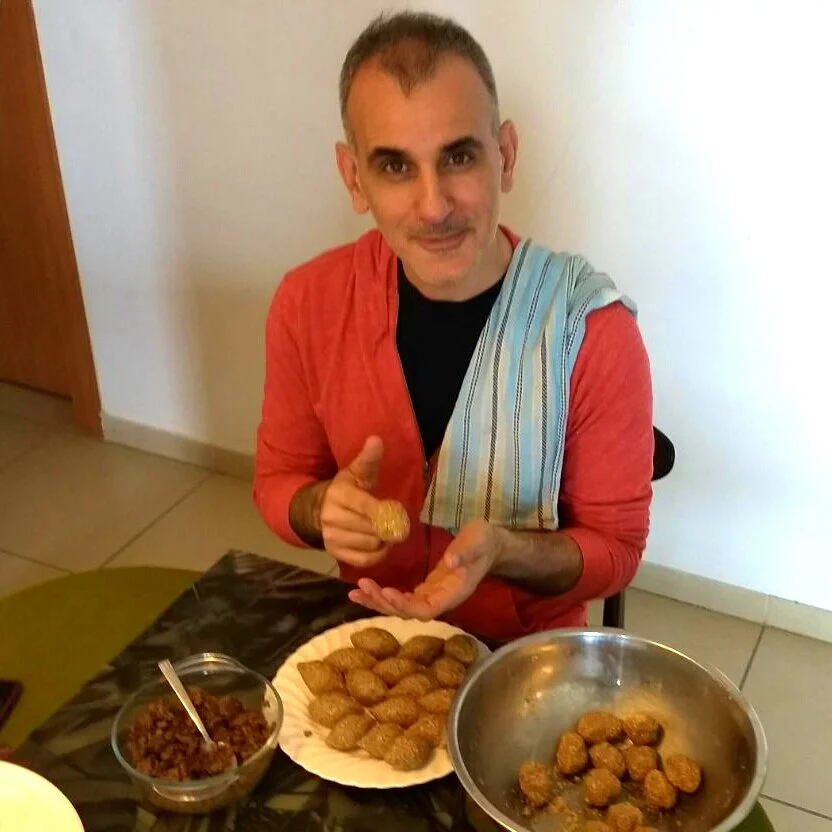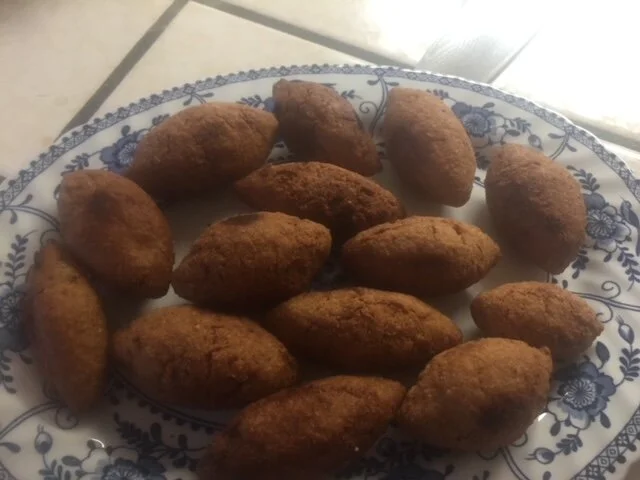Pesach Recipes
Doron’s Kutele • Rinat’s Kefte de Prasa and Kobebas •
Reb Irwin’s Kneidlach and Compote • Shari’s Sephardic-Style Haroset
Doron’s Kutele
I grew up eating kutele during Pesach. These filled plump dumplings are made of matzo meal and filled with beef, caramelized onions, pine nuts and spices, and cooked in chicken soup. I thought kneidlach were only for vegetarian people because only my vegetarian uncle ate matzo balls without filling. Only when I grew up and started visiting other people during Pesach did I realize it was my family that was the different one. After my Grandma Batya passed away, I tried for the first time to make kutele myself, and even though I’d never done it before, I had sat in her kitchen many times watching her well trained hands roll the dumplings. On my first try, my hands simply knew what to do, and I channeled my grandmother to create this joy of a dish, without which it doesn’t taste like Pesach to me.
For the Kutele dough:
1 lb Matzo meal
3 eggs
¼ cup canola oil
1 ½ cup water
For the filling:
2 large onions finely chopped
2 tbs olive oil
1 lbs ground beef (or ground turkey, or mushrooms, but the original is beef)
2 tsp cumin
1 tbs baharat (or mix some nutmeg, cardamom, clove, ginger and allspice)
Salt and pepper
1 bunch flat leaf parsley chopped
¼ cup Pine nuts or chopped walnuts (optional)
Preparation method:
Prepare the filling in advance and let cool:
Fry the onions in the oil until golden. Add the ground meat and break apart with a wooden spoon. Stir-fry until slightly brown. Add the spices, salt and pepper. Stir fry until well browned and the liquid is evaporated. Let cool. Add the nuts and the chopped parsley. This should already be yummy.
In a large bowl mix the matzo meal, eggs, oil, and 1 ¼ cups of the water. Knead until you get a soft and pliable dough. The test is that you can take a piece and flatten in to one eighth of an inch without it tearing. If the dough is too dry, add more water, one teaspoon at a time. Divide the dough into 1 inch balls, and cover, so they don’t dry out.
To make the kutele dumplings, take a ball of dough in your hand, with your finger create a small hole in the middle, and keep turning and pushing until you have a little dough bowl with very thin walls – the thinnest possible without it tearing or falling apart. Place a spoonful of filling in the middle, and pinch it closed, then roll to make it smooth and uniform.
At this stage you can freeze the kutele dumplings. They freeze really well.
When you want to serve, cook in chicken soup for about 30 minutes, until soft and plump. If you are cooking from frozen, there is no need to thaw it out.
Reb Irwin’s KneidlaCh
For me it’s not Pesach without matzahballs. I make them a day ahead and reheat them in the soup. But I like best eating them cold the day after seder. So I suggest making extra! This recipe starts with my Grandma Sade’s (3rd from the right in the photo) simple instructions; I added the brighter flavors. This is a small batch, so you might want to double or even triple it.
• Separate 3 eggs. Beat the whites until stiff. The meringue helps keep the kneidlach fluffy.
• Mix the yolks and 1/2 cup matzo meal. Add warm water or broth in small increments if necessary to make the batter uniform.
• Grate in a generous amount of fresh ginger and nutmeg.
• Add ample salt, pepper, and other favorite flavors. (Consider cumin, coriander, even curry powder. Or leave it gingery and nutmeggy.)
• Fold in egg whites. If having added water before results in a soupy mixture once the whites are folded in, sprinkle small amounts of matzo meal in incrementally until the batter is less liquidy. Chill for 1/2 hour.
• Form small balls and drop into boiling vegetable stock or water. (Don’t use the soup you’ll be serving – it will make the soup starchy.) The kneidlach will expand significantly.
• Cover the pot and boil for 10 minutes. Then lower the flame and let cook for 30 minutes. Drain and set aside.
• Place in bowls and ladle hot soup over them. Enjoy!
REB IRWIN’S Fruit Compote
Growing up I never knew if “compote” was an English word or a Yiddish one. (Short answer: it was French, and went both into English and Russian; hence my grandmother pronouncing it as if it were an Old Country word.) My grandmother always had some at the ready on Pesach as a sweet pareve dessert since seder was always fleishik. This is so easy, and so delicious. It can be dessert on its own, or served with meringues, or mixed into yogurt for breakfast. It will keep for a couple weeks.
Ingredients:
Dried fruit. Grandma Sade used prunes and apricots. I do too. But I also add dried mango, figs and crystallized ginger. I also like to add fresh pears if I have any that are just ripe but not yet mushy, and some fresh orange peel. But mostly, whatever looks delicious in the bulk section will be just right, any quantity you choose.
Cooking:
Put the dried fruit in a saucepan and barely cover with water. Bring the water to a boil, then drop to a simmer and cook covered until the fruit is nice and soft and the liquid has become dark and syrupy. Add more water if you need to. Let cool. Store in the fridge until you’re ready to eat it!
Rinat’s Kefte de Prasa
These are leek fritters – simple and easy and, in Rinat’s family, the flavor of Pesach.
Ingredients:
• 2 large leeks (choose ones with more white but use both the green and white part of the leeks)
• 4 eggs, beaten
• 1/2 cup matzo meal
• Salt, pepper and potentially other spices
• 5 walnuts (optional)
• vegetable oil for shallow frying
Instructions:
–– Wash the leeks really well and thinly slice both the white and the green parts.
–– Steam the leeks for about 5 minutes.
— squeeze all the liquids from the leeks.
— add eggs, matzo meal and salt and paper to taste.
— optionally add allspice and chili flakes
— optionally add finely chopped walnuts, for a more meaty flavor.
— heat the oil, form the mixture to patties just like latkes and shallow fry.
Rinat’s Kobebas
Rinat says: Not for the faint of heart but super delicious!
Filling: traditional filling is a gomo (detailed bellow) however you can make a vegetarian one as your imagination calls.
— 1/4 pound of ground beef and 1/4 pound of ground lamb (if you can get them custom ground and put through the grinder only once it will be better.)
— 1 Medium onion
— Salt, allspice and black paper to taste (my personal preference is less is more; at the same time, you want to have a warm flavor, and flavorful enough so that a little bit will still have a good taste.)
— Optional: a bit of dried mint
— Optional: pinenuts
— About two tablespoons of olive oil
Instructions for filling:
Sauté the onion in the olive oil, add the meat, add the spices. When ready, take off of the heat and let cool. This can be done ahead of time.
Shells
–– 1 cup matzo meal (it is possible to replace up to 1/4 of the matzo meal with rice flour; this is especially recommended for beginners as the dough will be more workable)
–– Salt
–– Water
Instruction:
Mix matzo meal with salt. Add a bit of water until you get a dough that is not too sticky. Very little water goes a long way. Let it rest for about half an hour.
To make the kobebas:
This is the part that is “not for the faint of heart.” But really you just need some patience. The kobebas are small pointy dumplings in a shape of a pointed football. You do not want the kobebas’ walls to be too thick because it will not taste good. You also do not want it to be so thin that it will fall apart…
• With wet hands, take a small amount of the shell mixture (about the size of a small egg) and shape into a ball.
• Make a hole with your finger, starting at one end of the egg shaped shell mixture – press in almost to the other side
• Turning the shell, thin out the walls with your fingers until they are thin - about 1/4 inch thick. Keep your hands moist to keep the shell mixture from sticking to your hands.
• Spoon in about a teaspoon of the meat filling and pinch seal the end to close the kobeba.
Once you assemble the kobebas you can freeze them and then fry them on the day of passover. Or they will also keep for about a day in the refrigerator (before frying.) They can be eaten room temperature but they are nice when freshly fried.
• Fry the kobebas in a frying pan until they are a deep golden brown
• Place the kobebas on a paper towel to draw out the excess oil and serve
Shari’s Sephardic Style Charoset
Several years ago I went searching for an alternative to the Charoset of my childhood. Don’t get me wrong, I love that Ashkenazi mix of walnut, apple, cinnamon and Manischewitz but I was looking for a recipe suitable for my friend with a severe nut-allergy. I found and tried several recipes over the years and this became a favorite. It’s tasty, easy, looks like mortar, can be nut free and/or alcohol free.
Ingredients:
1 1/2 cups red wine (recommended: Cabernet Sauvignon or Manischewitz) or concord grape juice
2 1/2 cups red raisins
1 1/2 cups dried dates, chopped fine
3/4 cup dried apricots, chopped fine
1/2 tsp cinnamon
1/4 tsp ground cloves
1/2 tsp kosher salt, or more to taste
1 1/2 cups roasted almonds (optional)
1 tsp orange blossom water (optional)
1/2 tsp cinnamon
2 1/2 cups red raisins
1 1/2 cups dried dates, chopped fine
Procedures:
1. Bring wine to a light simmer on medium heat, then stir in fruit and spices. Cook uncovered until fruit is well hydrated and wine has reduced to a thick syrup, about 15 minutes. Add salt to taste and set aside.
2. In a food processor, roughly chop almonds in short pulses. There should be no whole almonds remaining; a mix of large chunks and small crumbs is preferable. Transfer to a large mixing bowl.
3. Add fruit mixture to food processor and pulse until fruit just begins to come together into a paste, 2 to 3 one-second pulses. Do not over-process; large chunks of fruit should be intact.
4. Transfer fruit to mixing bowl and combine well with almonds. Stir in orange blossom water and additional salt if needed. Flavor of charoset will improve over time. Serve warm or at room temperature.





